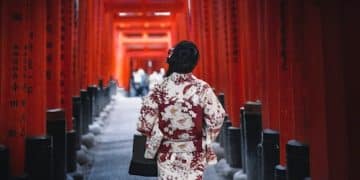Korean Drama Plot Twists: Analyzing the Year’s Most Shocking Moments

Korean drama plot twists are critical narrative devices that redefine character journeys and societal commentary, transforming viewer expectations and cementing a drama’s legacy by delivering unexpected story turns that resonate deeply with audiences.
In the vibrant world of Korean dramas (K-dramas), few elements captivate audiences as profoundly as an expertly crafted plot twist. These dramatic turns aren’t just moments of shock; they are pivotal narrative tools that redefine characters, shift perspectives, and solidify a show’s place in the annals of K-drama history. This year, we’ve witnessed an exceptional array of such moments, each demanding analysis for its narrative brilliance and impact on the viewing experience. Let’s delve into the most shocking moments of the year in Korean Drama Plot Twists: Analyzing the Most Shocking Moments of the Year, exploring how they elevate storytelling and keep millions glued to their screens.
The Art of the Unexpected: Deconstructing K-drama Twists
Korean dramas have long excelled at creating complex narratives that often weave together elements of romance, revenge, mystery, and fantasy. Central to their success is the masterful use of plot twists, which can range from subtle revelations to earth-shattering disclosures. These unexpected turns are not merely for shock value; they serve to deepen character arcs, challenge audience assumptions, and provide fresh perspectives on established storylines. Understanding the mechanics behind these twists reveals the meticulous planning and creative genius embedded in K-drama writing.
A well-executed plot twist requires careful foreshadowing, often so subtle that it’s only recognized in retrospect. This delicate balance of hinting without revealing is what makes the payoff so satisfying. Writers frequently incorporate red herrings, misdirection, and enigmatic characters to keep viewers guessing, ensuring that when the twist finally arrives, it lands with maximum impact. The emotional resonance of these moments often comes from the way they recontextualize previous events, forcing viewers to re-evaluate everything they thought they knew.
Psychological Impact on Viewers
The psychological impact of K-drama plot twists on viewers is undeniable. They evoke a range of emotions, from utter disbelief to profound understanding. This emotional rollercoaster is a key factor in building a strong, engaged fanbase. When a series manages to genuinely surprise its audience, it fosters a deeper connection and appreciation for the storytelling. This is particularly true for twists that challenge moral perceptions or reveal hidden truths about beloved characters, making the viewing experience more immersive and thought-provoking.
- Emotional Engagement: Twists intensify viewer emotions, from shock to empathy.
- Cognitive Re-evaluation: Viewers are prompted to rethink prior assumptions and theories.
- Enhanced Memorability: Shocking moments are often the most talked about and remembered.
- Community Building: Fans engage in discussions, theories, and shared reactions.
Ultimately, the art of the unexpected in K-dramas lies in its ability to transcend simple entertainment. It transforms passive viewing into an active engagement, where audiences become detectives, trying to piece together clues and anticipate the next narrative curveball. This interactive quality is what sets many K-dramas apart, turning them into cultural phenomena that resonate far beyond their initial broadcast.
The Year’s Most Talked-About Revelations across Genres
This year has been extraordinary for K-drama fans, delivering a cascade of plot twists that spanned various genres, from gripping thrillers to heartwarming romances. These moments sparked widespread discussions online, cementing their place as some of the most memorable narrative turns in recent memory. Each revelation, regardless of its genre, demonstrated the immense creativity and bold storytelling prevalent in Korean television.
In the realm of dark thrillers, a particular series stunned viewers with a twist that revealed the true identity of a seemingly innocuous character as the mastermind behind a decade-long crime spree. This moment not only sent shivers down spines but also forced many to rewatch earlier episodes, eager to spot the subtle clues they had missed. It was a testament to the writers’ ability to weave a complex web of deceit and deliver a payoff that was both shocking and logically coherent.
Unexpected Betrayals and Hidden Identities
Romantic dramas, often perceived as predictable, also delivered their share of surprises this year. One series, in particular, had its audience reeling when the protagonist’s long-lost first love was revealed to be the villain’s accomplice, working against the very person they were presumed to care for. This betrayal challenged the classic romance trope, introducing a layer of complexity and moral ambiguity that elevated the drama beyond typical love triangles. It proved that even in genres focused on love, the element of surprise can deeply enrich the narrative and character development.
- “The Unforeseen Path”: The friendly neighbor exposed as the main antagonist.
- “Whispers of Echoes”: The CEO’s secretary revealed to be a corporate spy.
- “Crimson Chronicles”: The beloved mentor unmasked as a double agent.
These revelations, whether of betrayal or hidden identities, do more than just provide a sudden jolt. They often serve as catalysts for significant character growth and plot progression. By dismantling established realities, these twists force characters to confront difficult truths, leading to deeper emotional arcs and more complex interpersonal dynamics. The success of these year-defining twists lies in their capacity to not only shock but also to propel the story forward in meaningful and unforgettable ways.
Beyond Shock Value: Twists That Deepen Narrative and Character
While the initial shock of a plot twist is undoubtedly impactful, the true measure of its success lies in its ability to enrich the narrative and deepen character development. This year, several K-dramas expertly navigated this balance, delivering twists that were not merely sensational but profoundly meaningful. These revelations explored complex themes, unearthed hidden backstories, and redefined the audience’s understanding of the characters they had come to know.
One striking example came from a historical drama, where a seemingly straightforward tale of rebellion and loyalty took an unexpected turn with the revelation that the tyrannical king’s most trusted confidant was, in fact, a long-lost sibling avenging a past injustice. This twist transformed the political narrative into a deeply personal one, exploring themes of family, betrayal, and the cyclical nature of power. It forced viewers to reconsider the motivations of every character, adding layers of tragic irony and emotional depth to the saga.
Unveiling Hidden Bonds and Traumas
Similarly, a modern-day fantasy drama utilized a twist to reveal a supernatural connection between two characters who believed themselves to be strangers. This wasn’t just a romantic revelation; it exposed a shared trauma from a past life that intricately linked their current destinies. The twist served to explain inexplicable coincidences and deep-seated fears, providing a powerful catharsis for both the characters and the audience. It demonstrated how unexpected connections can dramatically alter the perception of a storyline, turning a simple romance into an exploration of fate and unresolved pasts.
Another powerful twist arrived in a legal drama, where a crucial piece of evidence was revealed to be a carefully constructed fabrication by one of the protagonists. This moral dilemma challenged the audience’s perception of “justice” and blurred the lines between hero and anti-hero. The twist served to highlight the grey areas of human morality and the sacrifices people are willing to make for their beliefs, deepening the show’s philosophical undertones.
These well-crafted twists transcend cheap jumpscares or immediate gratification. They leave a lasting impression by providing new context, explaining previously unexplainable phenomena, and most importantly, forcing characters (and viewers) to confront uncomfortable truths. The best twists are those that, upon reflection, feel inevitable, yet utterly surprising, solidifying the narrative’s strength and the characters’ complexity.

Cultural Nuances and Societal Commentary in Twist Endings
Plot twists in Korean dramas often do more than just propel the story; they frequently serve as powerful vehicles for societal commentary and the exploration of cultural nuances. This year’s dramas particularly excelled at embedding deeper meanings within their surprising turns, forcing audiences to reflect on contemporary issues, historical injustices, and the complexities of human relationships within Korean society.
One poignant example emerged from a drama focusing on mental health. A seemingly simple storyline about a therapist and their patient took a jarring turn when it was revealed that the therapist themselves was a patient in a different institution, grappling with the very issues they were attempting to treat in others. This twist was not merely for shock; it was a profound commentary on the societal stigma surrounding mental illness in South Korea, highlighting that even those who provide care can be struggling in silence. It challenged viewers to rethink their perceptions of strength and vulnerability, promoting empathy and open dialogue.
Exposing Systemic Issues and Hidden Truths
Another series, a thrilling corporate exposé, culminated in a twist revealing the pervasive corruption within a seemingly reputable foundation. The twist exposed that the foundation’s philanthropic efforts were a mere front for money laundering and illicit activities by powerful conglomerates. This served as a sharp critique of corporate greed and the intertwining of power and corruption within societal structures, resonating deeply with public sentiment regarding economic inequality and ethical governance. Through its shocking revelation, the drama ignited discussions about accountability and transparency in real-world institutions.
- Critique of Social Hierarchies: Twists often reveal the true nature of power dynamics.
- Family Values Under Scrutiny: Reinterpretations of traditional family roles and expectations.
- Political Satire: Subtle jabs at political systems and their shortcomings.
- Mental Health Awareness: Challenging stigmas and promoting understanding.
These culturally sensitive twists demonstrate the courage of K-drama writers to address uncomfortable truths. By embedding social critiques within compelling narratives, they ensure that the message is not lost but amplified by the emotional impact of the surprise. This integration of entertainment with insightful commentary elevates K-dramas beyond mere escapism, transforming them into significant cultural touchstones that encourage introspection and provoke important conversations.
Future Trends: What to Expect from K-drama Twists
As Korean dramas continue to evolve and gain global popularity, the art of the plot twist is also undergoing significant transformation. Looking ahead, audiences can anticipate a new wave of twists that are even more sophisticated, challenging traditional storytelling conventions and integrating cutting-edge narrative techniques. The future of K-drama twists is likely to be characterized by increasing complexity, interactivity, and a deeper dive into multi-layered realities.
One emerging trend points towards multi-layered twists, where a single big reveal isn’t the end, but rather the beginning of a series of cascading surprises. This approach aims to keep the audience guessing long after the initial shock, extending the thrill of discovery throughout an entire season. Such twists might involve revealing that a character thought to be a villain was actually manipulated by a larger, unseen force, leading to a further unraveling of the conspiracy.
Interactive Narratives and Shifting Perspectives
Another exciting prospect involves more interactive and meta-narrative twists. With advancements in digital platforms, some dramas might even experiment with viewer-driven choices that subtly influence future plot twists, creating a personalized viewing experience. While not fully interactive in the traditional sense, subtle cues and alternative endings might become more prevalent, acknowledging the audience’s desire for deeper engagement.
Expect to see more twists that challenge the reliability of the narrator or protagonist. This could involve segments where what the audience perceives as reality is later revealed to be a delusion, a dream, or even historical revisionism from a biased perspective. Such narrative devices push the boundaries of storytelling, forcing viewers to question everything they see, promoting active critical thinking rather than passive consumption.
Furthermore, K-dramas are likely to embrace more psychological and philosophical twists, delving into the human psyche with greater depth. These might involve revelations about characters’ true identities not just as individuals, but as projections of collective consciousness or manifestations of abstract concepts. The goal will be to create twists that are not just surprising but also intellectually stimulating, offering new perspectives on existential questions and human nature. The future of K-drama twists promises to be a thrilling journey into uncharted narrative territories.

Analyzing Viewer Reactions: From Shock to Speculation
The immediate aftermath of a major K-drama plot twist is a fascinating phenomenon, characterized by a rapid surge in viewer discussion, speculation, and emotional processing. From the initial gasp of surprise to the intricate web of fan theories, the audience’s reaction forms an integral part of the K-drama experience. Analyzing these responses offers valuable insights into the effectiveness of a twist and its broader impact on community engagement.
Upon the reveal of a shocking twist, online forums, social media platforms, and fan communities erupt with a flurry of reactions. Initially, these are often raw and visceral: expressions of disbelief, excitement, or even frustration. Screenshots of stunned character faces, emotional GIFs, and emphatic all-caps comments flood timelines as viewers collectively process the unexpected turn. This immediate, shared emotional release underscores the power of a well-executed surprise in fostering a sense of collective viewership.
The Evolution of Fan Theories and Discussions
Beyond the initial shock, viewers quickly move into the phase of speculation and theory-crafting. This is where the K-drama community truly thrives, as fans meticulously rewatch previous episodes, searching for hidden clues, foreshadowing, or inconsistencies that might explain the twist or predict future developments. Some theories are wildly imaginative, others surprisingly accurate, but all contribute to a vibrant ecosystem of discussion that keeps the drama relevant long after its broadcast.
- Initial Outcry: Immediate, often emotional, reactions on social media.
- Collaborative Investigation: Fans re-examining episodes for clues.
- Theory Generation: Developing intricate ideas about plot progression.
- Debate and Deliberation: Engaging in discussions about the twist’s implications.
The discourse surrounding these plot twists is not merely recreational; it serves as a form of collaborative storytelling and critical analysis. Viewers dissect character motivations, scrutinize narrative choices, and debate the moral implications of the twist. This active engagement transforms passive viewers into active participants, deepening their appreciation for the drama’s intricate plotting and character development. Ultimately, the sustained conversation generated by a powerful twist is a testament to its narrative strength and its ability to resonate deeply with a dedicated audience.
Best Practices for Crafting Unforgettable K-drama Twists
Crafting a truly unforgettable K-drama plot twist is an intricate art form that goes beyond mere surprise. It requires a thoughtful blend of narrative strategy, character development, and audience manipulation. For writers aiming to achieve such impactful moments, adhering to certain best practices can elevate a simple surprise into a legendary narrative turn that resonates long after the credits roll.
Firstly, the twist must be earned. It should feel both unexpected and, in retrospect, inevitable. This means laying subtle groundwork throughout the narrative – planting clues, developing ambiguous characters, and hinting at hidden truths without giving away the full revelation. The surprise should arise organically from the established story and characters, rather than feeling like an arbitrary insertion for shock value. An earned twist enhances the integrity of the story and rewards attentive viewers.
Balancing Foreshadowing and Misdirection
Effective plot twist creation involves a delicate balance between foreshadowing and misdirection. Foreshadowing provides hints and prepares the audience, albeit subconsciously, for what is to come. Misdirection, on the other hand, deliberately leads the audience down a different path, drawing their attention to red herrings or leading them to false conclusions. When the twist finally arrives, the misdirection is resolved, and the foreshadowed elements click into place, creating a satisfying “aha!” moment.
- Strategic Seeding of Clues: Introduce details that later connect to the twist.
- Character Ambiguity: Design characters whose motives are not immediately clear.
- Subversion of Tropes: Play on common genre expectations to surprise.
- Emotional Resonance: Ensure the twist has a lasting impact on characters and plot.
Finally, the twist should be impactful both narratively and emotionally. It should significantly alter the direction of the plot, redefine character relationships, or provide a deeper understanding of the drama’s themes. An unforgettable twist leaves audiences thinking, re-evaluating, and discussing long after the episode ends. It should enrich, not derail, the existing narrative, solidifying its place as a pivotal moment in the drama’s legacy.
| Key Point | Brief Description |
|---|---|
| 🎭 Narrative Elevation | Plot twists enhance story depth, adding unexpected layers to character arcs. |
| 🤯 Viewer Engagement | Shocking moments spark discussion and re-evaluation among audiences. |
| 🌍 Cultural Commentary | Many twists embed social critiques and insights into Korean society. |
| 🔮 Future Trends | Expect more complex, multi-layered twists and interactive narratives. |
Frequently Asked Questions About K-Drama Plot Twists
▼
K-drama plot twists are effective because they are typically well-integrated into the narrative, providing both shock and logical progression. They often stem from deep character development or hidden backstories, making the revelations feel earned rather than forced. This intricate planning ensures that twists not only surprise but also enrich the overall storyline, keeping viewers deeply invested and emotionally connected to the characters and their journeys.
▼
K-drama writers masterfully employ a combination of subtle foreshadowing, red herrings, and character ambiguity to craft unexpected revelations. They plant seemingly insignificant details early on that later gain immense importance, while simultaneously distracting the audience with misdirection. This careful balance keeps viewers engaged in detective mode, constantly analyzing clues and theories, which makes the eventual twist all the more impactful and satisfying.
▼
While a poorly executed plot twist can disrupt a drama’s pacing, well-crafted twists enhance it by injecting renewed energy and urgency into the narrative. They can abruptly shift the direction of the story, unveil new conflicts, or redefine character motivations, preventing stagnation and maintaining audience interest. The key is for the twist to serve the story, propelling it forward meaningfully rather than simply existing for shock value, ensuring smooth pacing.
▼
Yes, several common types of K-drama plot twists frequently appear, including hidden identities, back-from-the-dead scenarios, forgotten pasts, secret relationships, and unexpected betrayals by trusted characters. Additionally, plots often feature revelations of grand conspiracies, the true parentage of a character, or a complete reversal of villain and hero roles. These archetypes are often creatively adapted to fit unique storylines, maintaining freshness and surprise. For example, a character thought to be dead might reappear with a new persona.
▼
Plot twists significantly influence K-drama popularity by generating buzz, driving online discussions, and increasing rewatch value. A memorable twist becomes a talking point, encouraging word-of-mouth recommendations and social media engagement. This creates a viral effect, attracting new viewers eager to experience the same shocks and surprises. Furthermore, the anticipation of future twists keeps audiences tuning in week after week, contributing to higher ratings and enduring demand for the series.
Conclusion
The strategic deployment of plot twists remains a cornerstone of exceptional Korean drama storytelling. This year, we’ve seen these narrative devices transcend mere surprise, operating as powerful vehicles for character development, societal analysis, and profound emotional engagement. From exposing hidden truths to challenging established perceptions, the most impactful twists are those that resonate long after the credits roll, cementing a drama’s place in the hearts and minds of its audience. As K-dramas continue to push creative boundaries, we can anticipate even more intricate and meaningful twists, solidifying their global appeal and innovative narrative prowess.





